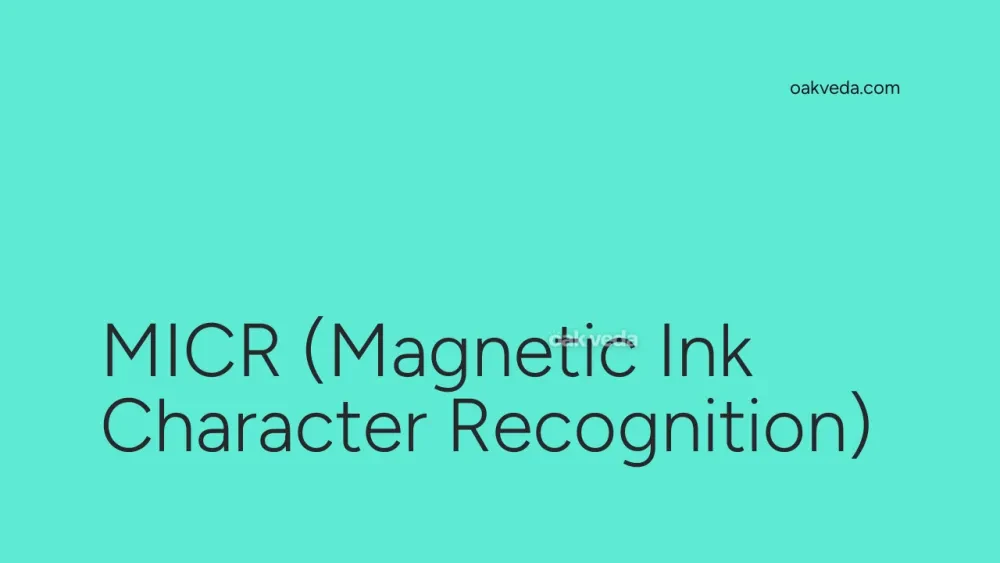
What is the Full Form of MICR?
MICR is the abbreviation for Magnetic Ink Character Recognition. This technology plays a crucial role in the banking and financial sectors, providing a secure and efficient method for processing documents, particularly checks.
What is Magnetic Ink Character Recognition?
Magnetic Ink Character Recognition, commonly known as MICR, is a character recognition technology used to verify the legitimacy of paper documents, especially checks. It involves printing characters in special magnetic ink or toner, which can be read by machines designed for this purpose.
Origin and Development of MICR
The MICR technology was developed in the 1950s to address the growing need for faster check processing in the banking industry. As the volume of checks increased, manual processing became time-consuming and error-prone. MICR was introduced as a solution to automate and streamline this process.
How does MICR work?
MICR technology works on the principle of magnetism. Here's a step-by-step explanation of the process:
- Special characters are printed using magnetic ink on the document.
- When the document passes through an MICR reader, the magnetic ink is magnetized.
- The reader detects the magnetic signal from these characters.
- The signal is then converted into digital information that can be processed by computers.
This process allows for quick and accurate reading of important information, even if the document has been marked with stamps, signatures, or other non-magnetic ink.
Types of MICR Fonts
There are two primary types of MICR fonts used globally:
- E-13B: This font is widely used in North America, the United Kingdom, and several other countries.
- CMC-7: This font is predominantly used in France, Spain, and most South American countries.
Functions of MICR
The primary functions of MICR technology include:
- Document Verification: Ensuring the authenticity of checks and other financial documents.
- Automated Processing: Enabling high-speed, accurate processing of checks.
- Fraud Prevention: Making it difficult to forge documents due to the unique properties of magnetic ink.
- Error Reduction: Minimizing human errors in reading and processing financial documents.
Applications of MICR
While MICR is most commonly associated with check processing, its applications extend to various areas:
- Banking: Processing checks and other financial documents.
- Retail: Handling gift certificates and coupons.
- Government: Processing tax forms and other official documents.
- Healthcare: Managing insurance claims and patient records.
Features of MICR
MICR technology boasts several key features that make it invaluable in financial transactions:
- High Accuracy: Even when documents are marked or stamped, MICR can read characters with high precision.
- Speed: MICR readers can process hundreds of documents per minute.
- Security: The use of magnetic ink makes it difficult to alter or forge documents.
- Standardization: MICR codes follow a standardized format, ensuring consistency across different banks and financial institutions.
Benefits of MICR
The adoption of MICR technology offers numerous benefits:
- Increased Efficiency: Faster processing of checks and other documents.
- Reduced Errors: Minimizes mistakes associated with manual data entry.
- Enhanced Security: Makes document forgery more challenging.
- Cost-Effective: Reduces labor costs associated with manual processing.
- Improved Customer Service: Enables faster transaction processing and fund availability.
Limitations or Challenges of MICR
Despite its advantages, MICR technology does face some challenges:
- Cost: Initial setup and maintenance of MICR systems can be expensive.
- Limited Character Set: MICR fonts typically include only numbers and a few special symbols.
- Dependence on Magnetic Ink: Documents must be printed with specific magnetic ink for MICR to work effectively.
- Technological Advancements: With the rise of digital banking, the relevance of MICR in check processing may decrease over time.
Future Developments in MICR Technology
While digital banking is on the rise, MICR technology continues to evolve:
- Integration with Digital Systems: MICR is being integrated with digital banking platforms for seamless processing.
- Enhanced Security Features: Ongoing research aims to make MICR even more secure against forgery attempts.
- Expanded Applications: MICR technology is finding new applications beyond banking, such as in secure document management systems.
FAQs on MICR Full Form
-
What is the MICR code on a check? The MICR code on a check is a unique 9-digit code that identifies the bank and branch. It consists of three parts: city code (3 digits), bank code (3 digits), and branch code (3 digits).
-
How is MICR different from IFSC code? While both are used in banking, MICR codes are primarily used for check processing, whereas IFSC (Indian Financial System Code) is used for electronic fund transfers like NEFT and RTGS.
-
Can MICR codes be read by humans? Yes, MICR codes are printed in a special font that is both machine-readable and human-readable.
-
Is MICR technology still relevant in the age of digital banking? Yes, MICR remains relevant, especially in countries where check usage is still common. It also finds applications in other areas requiring secure document processing.
-
How secure is MICR technology? MICR is highly secure due to the use of special magnetic ink and standardized fonts, making it difficult to forge documents.
In conclusion, MICR, or Magnetic Ink Character Recognition, continues to play a vital role in secure document processing, particularly in the banking sector. Its ability to provide fast, accurate, and secure reading of financial documents makes it an enduring technology in our increasingly digital world.
You may be interested in:

